20x32x6 Oil Seal Specifications and Application Information for Industrial Use
Understanding the Oil Seal A Deep Dive into 20x32x6 Specifications
Oil seals, also known as fluid seals or grease seals, are vital components in various mechanical systems. They play a crucial role in preventing the leakage of lubricants and contaminants, ensuring system efficiency and longevity. One common specification seen in many automotive and industrial applications is the oil seal measuring 20x32x6 mm. Let’s explore its features, functions, applications, and advantages.
Dimensions Explained
The designation 20x32x6 refers to the dimensions of the oil seal, which are expressed in millimeters. Here, 20 represents the inner diameter, 32 signifies the outer diameter, and 6 denotes the thickness of the seal. These measurements are not arbitrary; they are carefully designed to fit specific shaft sizes and housings in various machinery.
The inner diameter of 20 mm fits snugly around a corresponding shaft, typically designed to rotate. The outer diameter of 32 mm allows the seal to fit securely inside the housing, which holds it in place. The thickness of 6 mm ensures structural integrity and durability, enabling the seal to withstand the pressures of various operating conditions.
Functions of Oil Seals
The primary function of an oil seal is to retain oil or lubricant within a mechanical system while preventing the ingress of dirt, dust, and other contaminants. This is particularly critical in rotating applications such as engines, gearboxes, and pumps, where maintaining the proper lubrication is essential for reducing friction and wear between moving parts.
Oil seals also help maintain pressure within an assembly, which is vital for the efficient operation of hydraulic systems. By providing a reliable barrier, these seals contribute to the overall health and functionality of machinery, reducing the likelihood of mechanical failure and extending maintenance intervals.
Material Composition
Oil seals are typically made from a variety of materials, including rubber compounds, polyurethane, and other elastomers. The choice of material depends on the specific application and the conditions under which the seal will operate. For instance, high-temperature applications may require seals made from silicone rubber, while more standard environments could use nitrile rubber, which offers excellent resistance to oil and abrasion.
oil seal 20x32x6

The lip of the oil seal is often designed to create a tight fit against the shaft, providing a dynamic seal that performs well even under varying pressure conditions. Some seals might also incorporate a metal casing for added structural support and longevity.
Applications of Oil Seal 20x32x6
The 20x32x6 oil seal can be found in a wide range of applications across various industries. In the automotive sector, it is commonly used in engines, transmissions, and differential assemblies. These seals ensure that the critical lubricants remain intact, thereby enhancing vehicle performance and reliability.
In industrial settings, oil seals are essential in machinery that involves rotating shafts, such as pumps and compressors. They help prevent costly leaks and protect internal components from contamination, which can lead to premature wear and damage.
Additionally, the agricultural sector employs these seals in equipment like tractors and harvesters. By ensuring that lubricants are properly retained, these seals contribute to the machinery's ability to perform heavy-duty tasks efficiently.
Advantages of Using Oil Seal 20x32x6
Utilizing an oil seal with the dimensions 20x32x6 comes with several benefits. Firstly, it enhances the reliability and efficiency of mechanical systems by minimizing lubricant loss and contaminant entry. Secondly, it reduces maintenance costs and downtime, as the need for frequent repairs and lubricant replacement is lessened.
Moreover, high-quality oil seals contribute to overall energy efficiency, potentially lowering operational costs in industrial settings by ensuring that machinery operates optimally.
Conclusion
The oil seal measuring 20x32x6 mm is a small but crucial component in ensuring the efficiency and longevity of various mechanical systems. Its role in retaining lubricants while preventing contamination cannot be overstated. As industries continue to evolve and require more sophisticated machinery, the importance of oil seals—and their various specifications—will undoubtedly remain at the forefront of engineering and maintenance challenges. Understanding these seals' dimensions, functions, applications, and benefits is essential for anyone involved in mechanical maintenance or design.
-
Simplifying Oil Changes: A Comprehensive Guide to Oil Drain Plugs and Their Variants
News Aug.04,2025
-
Mastering Oil Drain Maintenance: Solutions for Stripped, Worn, and Upgraded Oil Plugs
News Aug.04,2025
-
Fixing Oil Pan Plug Issues: Leaks, Stripped Nuts, and the Right Replacement Solutions
News Aug.04,2025
-
Everything You Need to Know About Oil Drain Plugs: Sizes, Fixes, and Upgrades
News Aug.04,2025
-
Choosing the Right Oil Drain Plug: A Guide to Sizes, Materials, and Drain Innovations
News Aug.04,2025
-
A Complete Guide to Automotive Drain Plugs: Types, Problems, and Innovative Solutions
News Aug.04,2025
-
The Ultimate Guide to Car Repair Kits: Tools and Essentials Every Driver Should Own
News Aug.01,2025
Products categories















